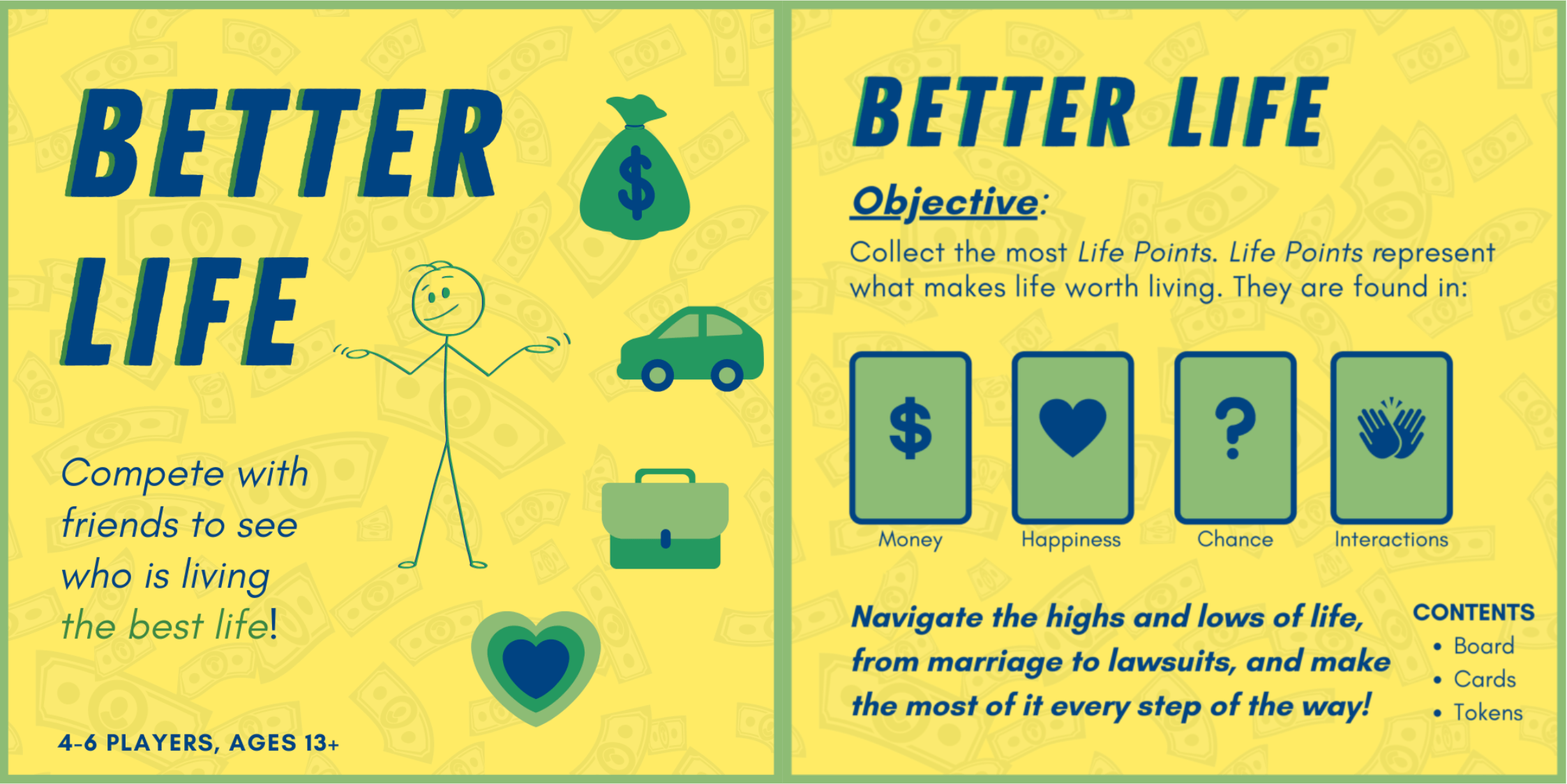Artist’s Statement
Imagine a life where you were focused on experiences, relationships, and overall, having a good time. Sure, there will always be financial worries, as well as other things going on in the world, but let’s forget about those for a second. Better Life is a social feel-good game that allows players to do just that. Throughout the game, you will interact with others, getting to know each other beyond the layers of strangers and friends and creating a deeper bond, all while trying to live the most well-rounded life. As the cards and dice decide your fate, players focus on earning “life points”, which symbolize all the little moments that make life worth living. Players earn life points through interactions that are meant to bring out their most genuine self – from the funniest dances per team member to getting (or getting someone) pregnant – and go through the journey of seeing others bring out their most genuine versions of themselves. The model on which Better Life is built is the major component that humans would encounter in their lives. We have four categories: money, happiness, interactions, and chance. Players will encounter scenarios tied to each of these categories and navigate making decisions and striving to live the most meaningful life.
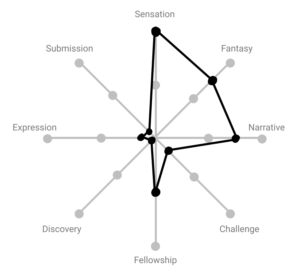
Concept Map
The following concept map showcases the different main ideas that stemmed from our project, and how each element came to be within these ideas.
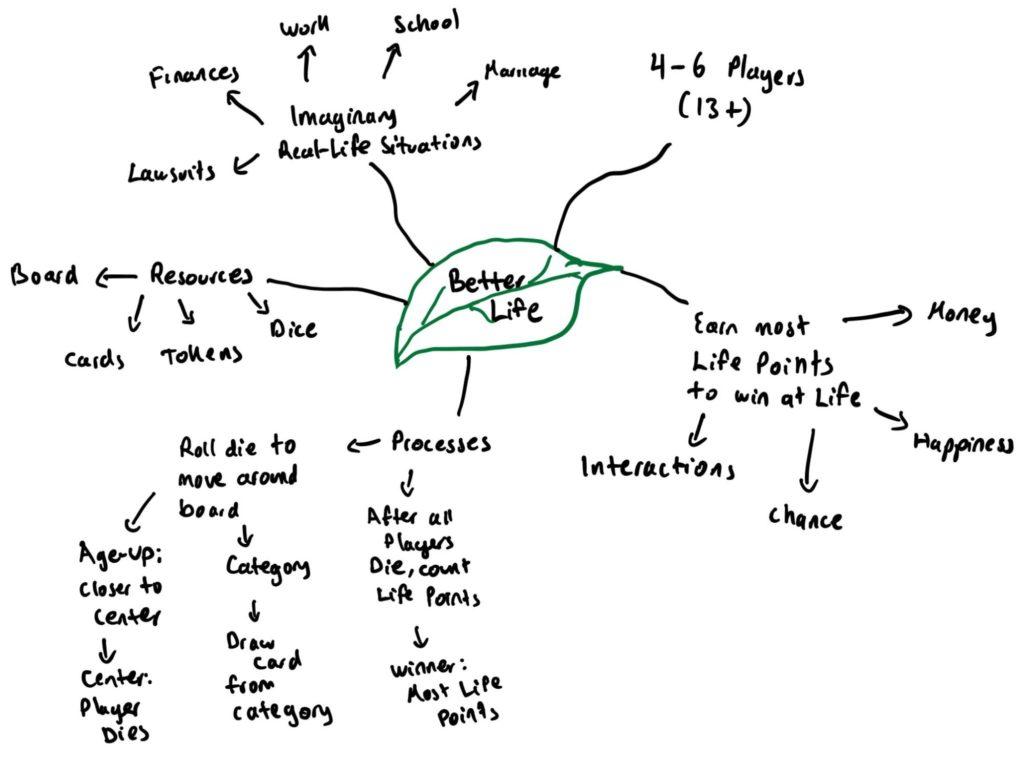
Initial Decisions
These are the formal elements of our game, as decided from our first round of playtesting (discussed below) and our initial ideas:
Players: 4-6
Ages: 14+
Objectives: Collect the most life points to win.
Outcomes: Zero-sum (1 winner, the rest are losers)
Rules/Procedures:
- Each player gets a place marker and places it on one of the four outer corners.
- Each player randomly picks a starting bonus card.
- Players with exchangeable bonuses should now exchange them. For example, if your starting bonus is “Collect two life points.”, you may take those points now.
- Each player rolls a die. The highest value goes first. Gameplay moves clockwise.
- Each turn:
- Roll the die
- Move that many spaces clockwise.
- If you land on a green age spot, move to the corner of the next inner square.
- Else: Draw a card from the corresponding deck and complete any actions.
- Gameplay continues clockwise (to the right).
- Collect points and have fun!
- Each player randomly picks a starting bonus card.
Resources
- Board
- Tokens
- Gameplay tokens (baby, car, house, pet, etc.)
- Marbles (Life Points) + container
- 6 place markers
Boundaries
Players will take on the role of someone else in life. They must interact with other players and earn life points, as well as roll dice when in turn in order to progress.
Types of fun
- Social Fun: Players must interact via the card selections and prompts.
- Capital (Financial) Management Fun: Players earn Life Points, which can increase or decrease depending on Players’ luck and decision-making abilities.
- Feel-Good Fun: We emphasize to players that money isn’t everything. Players are very well able to win the game by making decisions that benefit their wellbeing, instead of focusing solely on Money.
Values
Though we intend for the game to be a fun escape from the stresses of real life, we hope to emphasize to players that, in life, money is not everything! Life is great because of the happy (and spontaneous!) moments too. We also chose to keep the game (mostly) lighthearted, choosing to focus more on positive moments rather than negative moments. We want people to enjoy getting to know each other and working towards the most life points, rather than stress about the little things.
Testing and Iteration History
We conducted two rounds of playtesting during class with other students.
Playtest #1
Our original game was built on the idea of three decks of cards and a four-sided dice. We originally intended for the game to be solely card-based, and conducted a bricolage prototype using Quizlet and a four-sided dice simulator. Our initial experiences with this set-up allowed us to finalize the main components of our game, although we would later change many of the styles and format of the game.
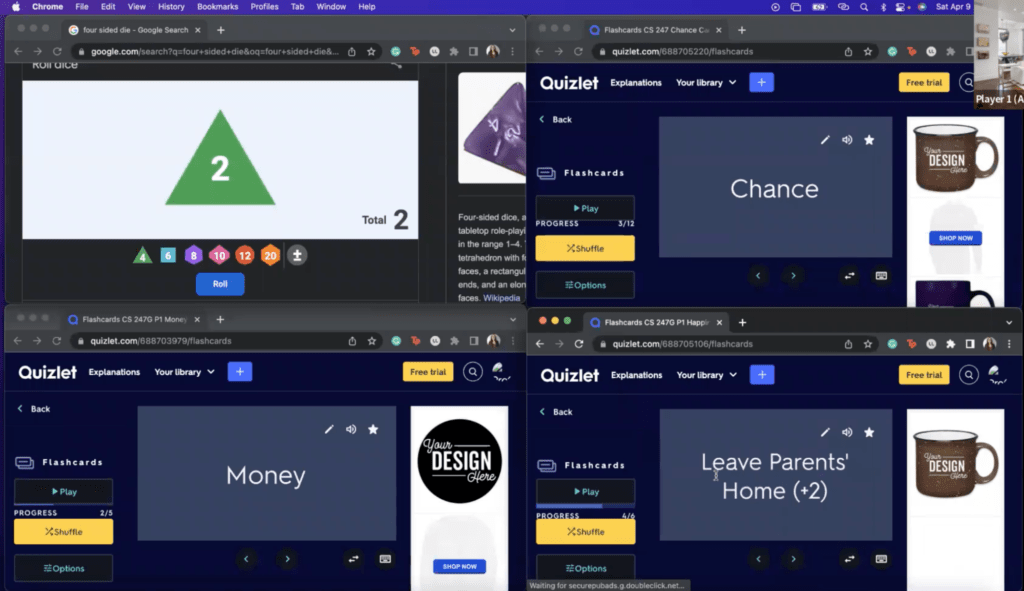
The purpose of this first round of playtesting was to test our initial ideas of creating a card-based game based on real-life situations.
Positive Feedback
Players enjoyed the concept and idea of building their own characters in the game.
Negative Feedback + Changes
1. Although this is a narrative/fantasy game, one player mentioned that they were not absorbed in the game. They requested for us to “think about how it can mean more.”
- We created a board so players can visualize their progress and incorporated a visual point system with marbles.
2. The players felt like they were just going through the motions and had little control over what happened to them.
- We created cards that allowed for more player choices.
3. It was unclear what you earn for some of the cards.
- We made the point values on each card clearer.
4. The players felt they could not keep track of their progress or see how they were doing in comparison to others.
- We added a physical representation of the life points (marbles) rather than relying on writing down the points.
Playtest #2
The purpose of this second playtest was to test how our original card-based game would translate into a board game. We wanted to test to see if the number of cards we created corresponded well with the size of the board/length of gameplay.
What went well
Players enjoys the clearer competition present in the game with the incorporation of physical points (marbles).
Negative Feedback + Changes
1. Players were a bit confused since the direction of movement on the board did not match the passing of the die / who goes next.
- We established a rule that the game and die would move counter-clockwise.
2. All cards were white with black text, so it was difficult to distinguish between card types
- Different card types are represented with different colors. The card labels are also much bigger/readable.
3. For some interaction cards, it was difficult to understand who gets the points.
- On each card, we adjusted phrases so it is clearer what actions must be taken and how the recipient of points is determined.
4. Some prompts were a bit difficult to answer (for example, thinking of a high school superlative for yourself and naming your coffee order)
- We made adjustments as needed. For example, we made it so players would think of a superlative for the person on their right and instead name their favorite beverage.
5. Some players were not satisfied with the point values of some cards. (For example, the dance battle card was worth only 1 point, despite being the card that requires the most physical effort.)
- We revised our card values and made it so more important cards were valued higher. We based importance on how strong of an effect the actual event would have on your life.
6. We ran out of cards around 80% through the game, and the game was dragging.
- We adjusted the board so there are fewer spots and the game ends quicker.
Design History
Game Design
Here were some of the many sketches that we drafted up when making the main translation from bricolage/cards only, to our new design:
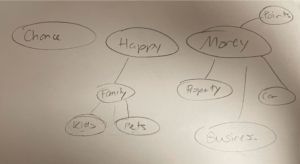
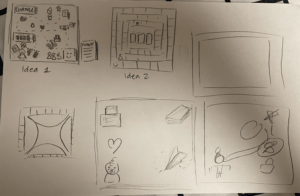

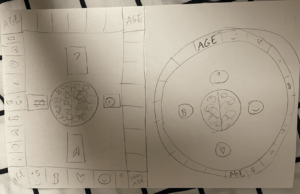
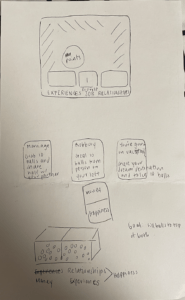

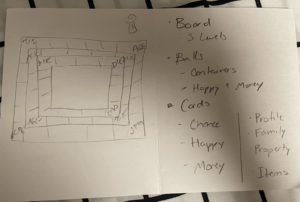
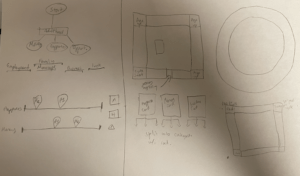
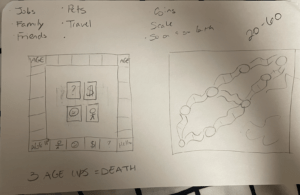
Box Design
We designed our box by indiviudally brainstorming ideas and combining them into a final design.
Initial Ideas:
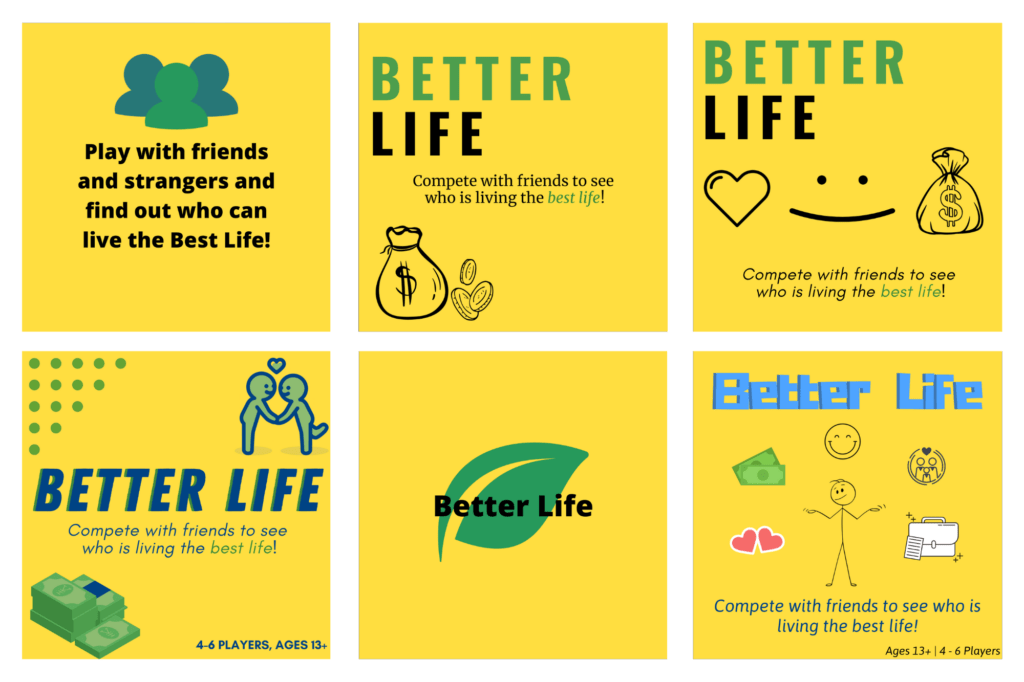
Final Design (front and back):
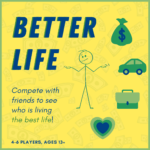
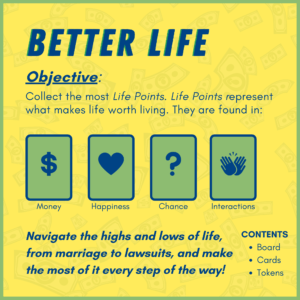
Final Prototype
You can access all of information at this link! You will see the board, cards, tokens, player checkpoints, and instruction manual.
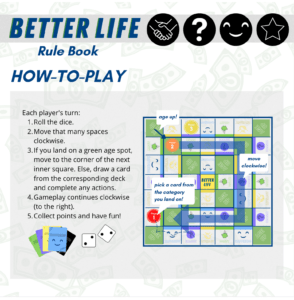
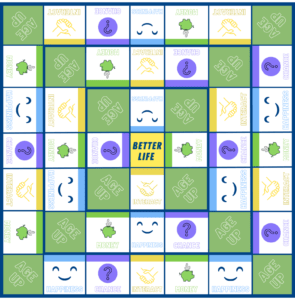
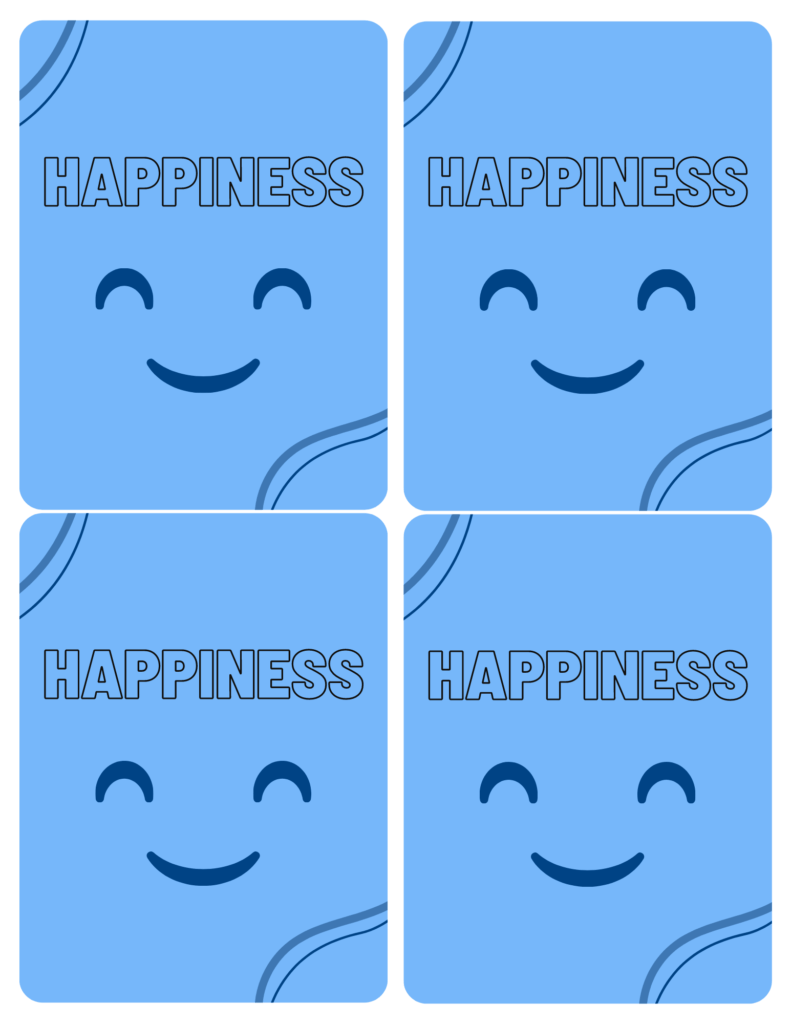
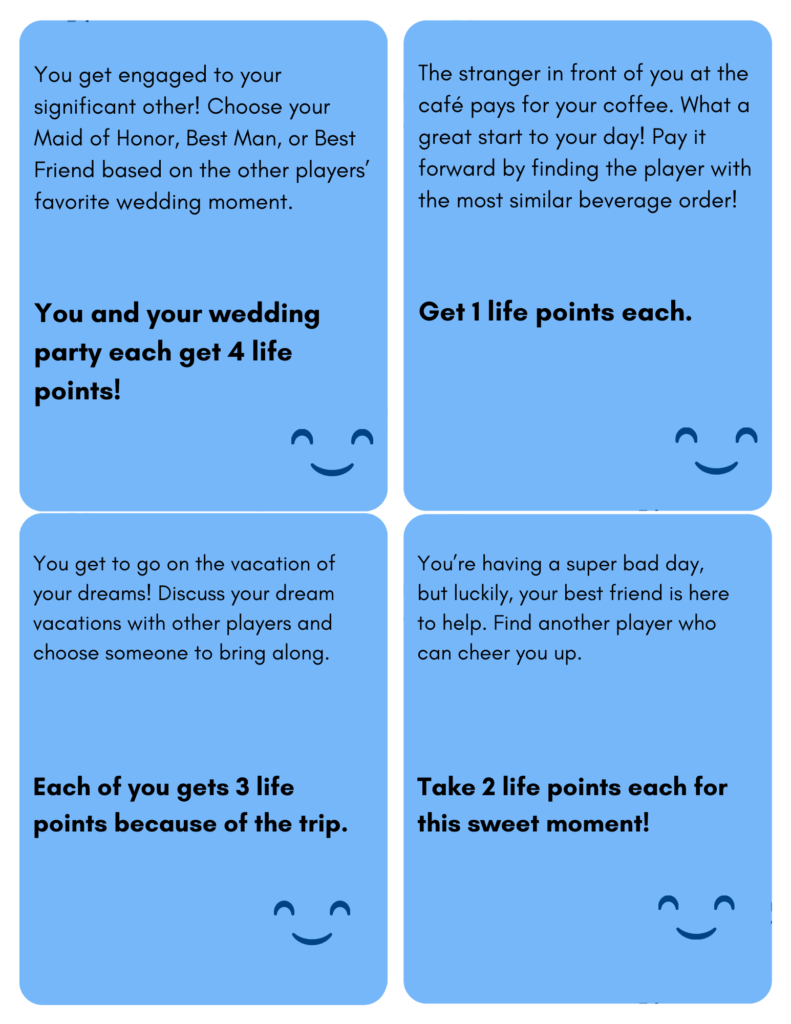
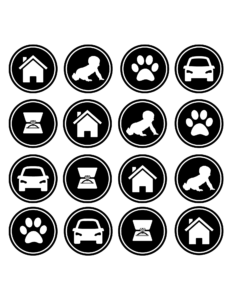
Playtest Video
Team Members
Amanda Huynh, Anna Chang, Selaine Rodriguez, Wilmer Zuna Largo


